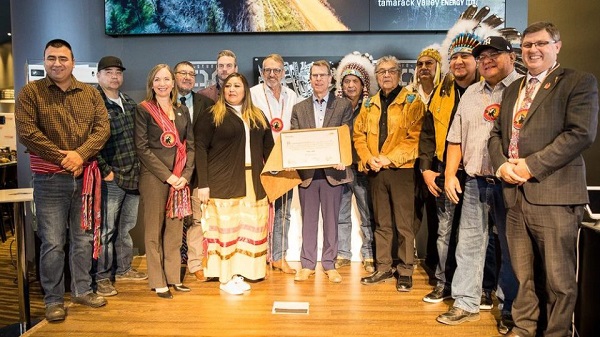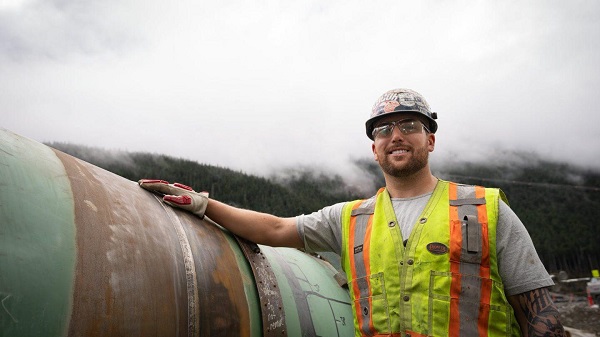Canadian Energy Centre
Alberta Indigenous energy ownership driving increased economic activity

In December 2023, the Alberta Indigenous Opportunities Corporation provided a $150 million loan guarantee to support the 12 Indigenous Communities of Wapiscanis Waseskwan Nipiy Limited Partnership (including the Peerless Trout First Nation) in financing an equity investment in oil and gas midstream infrastructure in the Clearwater play in Northern Alberta. Photo courtesy AIOC
From the Canadian Energy Centre
By Will Gibson
‘We live in a new world, and I’m excited about the possibilities’
Five pristine lakes sit in and around the Peerless Trout First Nation in the unbroken boreal forest of north-central Alberta about 200 kilometres north of Slave Lake.
When asked about the fishing, Tyler Letendre smiles wryly. “It lives up to the name,” says the Nation’s director of operations and economic development officer. “It’s peerless.”
The community’s leadership is exploring the idea of building a lodge to lure recreational anglers from across North America to reel in the large pike, trout and walleye that inhabit the dark blue waters in those lakes.
After joining the Clearwater Infrastructure Limited Partnership in December 2023 with 11 other Indigenous communities and Tamarack Valley Energy, they have the financial clout to develop a resort.
“Joining the partnership has been a game changer for our nation, 100 per cent. We won’t compromise on treaty rights, but we are big fans of economic growth,” says Letendre.
“The money provided by the federal government to First Nations isn’t enough to sustain the programs and infrastructure required so we have to generate our own income. Equity deals like Clearwater do that,” he says.
“We are shareholders along with major institutions. We now have banks who want to come invest in our communities. We live in a new world, and I’m excited about the possibilities.”

The Peerless Trout First Nation is located about 200 kilometres north of Slave Lake, Alberta. Photo courtesy Peerless Lake First Nation
The growing number and value of Indigenous equity ownership deals in Alberta is helping fuel stronger participation in the province’s economy, according to a recently released report from ATB Financial and MNP.
The study concluded that total Indigenous economic activity in Alberta grew by a substantial 42 per cent between 2019 and 2023.
Last year, Indigenous-owned businesses generated $5.25 billion in economic output, $380 million in tax revenues and $1.33 billion in labour income from 25,800 full-time jobs.
The resource sector has an outsized impact in this area as its relationship with First Nations and Métis communities in Alberta has evolved and grown.
“The fastest growing and largest opportunities for Indigenous communities in Alberta come from the resource sector,” says Justin Bourque, president of Âsokan Generational Developments, a consultancy that specializes in partnerships between Indigenous communities and industry.
He says the evolution of the relationship between Indigenous communities and the resource sector has mirrored the broader progress of reconciliation.
“Our entire society is on a journey of reconciliation between Indigenous and non-Indigenous communities. The engagement and relationship between the resource industry and Indigenous has continued to evolve.”
In recent years, particularly following the creation of the Alberta Indigenous Opportunities Corporation (AIOC) in 2019, these relationships have increasingly moved from short-term benefits to long-term legacies through equity ownership deals like Peerless Trout’s agreement with Tamarack Energy.

Justin Bourque, president of Âsokan Generational Developments, pictured on his trap line with the Long Lake oil sands facility in the background. Photo for Canadian Energy Centre
ATB highlighted the Astisiy project in the oil sands region, a Cree word meaning “thread from sinew” that is used for Indigenous beading.
In September 2021, Suncor Energy and the AIOC enabled eight Indigenous communities to acquire 15 per cent ownership of the Northern Courier Pipeline, a 90-kilometre system that transports bitumen from the Fort Hills mine to the East Tank Farm north of Fort McMurray.
The community partners are projected to receive $16 million in annual payments from the deal.
Bourque’s Willow Lake Métis Nation has used its portion of the revenues to purchase a 205-acre parcel southeast of Fort McMurray, giving the community land to call its own.
“Ownership and partnership is the next logical evolution of the relationship between Indigenous communities and the energy sector,” says Bourque.
“Before Indigenous communities had the opportunity to invest in these resource assets, a lot of the economic value out of these investments would flow to institutional investors along with the corporation,” he says.
“By having some of those benefits flow into Indigenous communities, it builds both resilience by giving them financial sovereignty and allows that community to address priorities and needs determined by them, not somebody in Ottawa.”
Opportunities are now happening at the Peerless Trout First Nation.
“Our chief and council are in the best position to decide what works for the 900 members of Peerless Lake when it comes to how to invest the monies from the partnership, whether that’s in housing, education, health care, more post-secondary scholarships or building a hockey arena or community facility,” Letendre says.
2025 Federal Election
Canada’s pipeline builders ready to get to work

From the Canadian Energy Centre
“We’re focusing on the opportunity that Canada has, perhaps even the obligation”
It was not a call he wanted to make.
In October 2017, Kevin O’Donnell, then chief financial officer of Nisku, Alta.-based Banister Pipelines, got final word that the $16-billion Energy East pipeline was cancelled.
It was his job to pass the news down the line to reach workers who were already in the field.
“We had a crew that was working along the current TC Energy line that was ready for conversion up in Thunder Bay,” said O’Donnell, who is now executive director of the Mississauga, Ont.-based Pipe Line Contractors Association of Canada (PLCAC).
“I took the call, and they said abandon right now. Button up and abandon right now.
“It was truly surreal. It’s tough to tell your foreman, who then tells their lead hands and then you inform the unions that those three or four or five million man-hours that you expected are not going to come to fruition,” he said.

Workers guide a piece of pipe along the Trans Mountain expansion route. Photograph courtesy Trans Mountain Corporation
“They’ve got to find lesser-paying jobs where they’re not honing their craft in the pipeline sector. You’re not making the money; you’re not getting the health and dental coverage that you were getting before.”
O’Donnell estimates that PLCAC represents about 500,000 workers across Canada through the unions it works with.
With the recent completion of the Trans Mountain expansion and Coastal GasLink pipelines – and no big projects like them coming on the books – many are once again out of a job, he said.
It’s frustrating given that this could be what he called a “golden age” for building major energy infrastructure in Canada.
Together, more than 62,000 people were hired to build the Trans Mountain expansion and Coastal GasLink projects, according to company reports.
O’Donnell is particularly interested in a project like Energy East, which would link oil produced in Alberta to consumers in Eastern and Atlantic Canada, then international markets in the offshore beyond.
“I think Energy East or something similar has to happen for millions of reasons,” he said.
“The world’s demanding it. We’ve got the craft [workers], we’ve got the iron ore and we’ve got the steel. We’re talking about a nation where the workers in every province could benefit. They’re ready to build it.”

The “Golden Weld” marked mechanical completion of construction of the Trans Mountain Expansion Project on April 11, 2024. Photo courtesy Trans Mountain Corporation
That eagerness is shared by the Progressive Contractors Association of Canada (PCA), which represents about 170 construction and maintenance employers across the country.
The PCA’s newly launched “Let’s Get Building” advocacy campaign urges all parties in the Canadian federal election run to focus on getting major projects built.
“We’re focusing on the opportunity that Canada has, perhaps even the obligation,” said PCA chief executive Paul de Jong.
“Most of the companies are quite busy irrespective of the pipeline issue right now. But looking at the long term, there’s predictability and long-term strategy that they see missing.”
Top of mind is Ottawa’s Impact Assessment Act (IAA), he said, the federal law that assesses major national projects like pipelines and highways.
In 2023, the Supreme Court of Canada found that the IAA broke the rules of the Canadian constitution.
The court found unconstitutional components including federal overreach into the decision of whether a project requires an impact assessment and whether a project gets final approval to proceed.
Ottawa amended the act in the spring of 2024, but Alberta’s government found the changes didn’t fix the issues and in November launched a new legal challenge against it.
“We’d like to see the next federal administration substantially revisit the Impact Assessment Act,” de Jong said.
“The sooner these nation-building projects get underway, the sooner Canadians reap the rewards through new trading partnerships, good jobs and a more stable economy.”
Canadian Energy Centre
First Nations in Manitoba pushing for LNG exports from Hudson’s Bay

From the Canadian Energy Centre
By Will Gibson
NeeStaNan project would use port location selected by Canadian government more than 100 years ago
Building a port on Hudson’s Bay to ship natural resources harvested across Western Canada to the world has been a long-held dream of Canadian politicians, starting with Sir Wilfred Laurier.
Since 1931, a small deepwater port has operated at Churchill, Manitoba, primarily shipping grain but more recently expanding handling of critical minerals and fertilizers.
A group of 11 First Nations in Manitoba plans to build an additional industrial terminal nearby at Port Nelson to ship liquefied natural gas (LNG) to Europe and potash to Brazil.
Robyn Lore, a director with project backer NeeStaNan, which is Cree for “all of us,” said it makes more sense to ship Canadian LNG to Europe from an Arctic port than it does to send Canadian natural gas all the way to the U.S. Gulf Coast to be exported as LNG to the same place – which is happening today.
“There is absolutely a business case for sending our LNG directly to European markets rather than sending our natural gas down to the Gulf Coast and having them liquefy it and ship it over,” Lore said. “It’s in Canada’s interest to do this.”
Over 100 years ago, the Port Nelson location at the south end of Hudson’s Bay on the Nelson River was the first to be considered for a Canadian Arctic port.
In 1912, a Port Nelson project was selected to proceed rather than a port at Churchill, about 280 kilometres north.
The Port Nelson site was earmarked by federal government engineers as the most cost-effective location for a terminal to ship Canadian resources overseas.
Construction started but was marred by building challenges due to violent winter storms that beached supply ships and badly damaged the dredge used to deepen the waters around the port.
By 1918, the project was abandoned.
In the 1920s, Prime Minister William Lyon MacKenzie King chose Churchill as the new location for a port on Hudson’s Bay, where it was built and continues to operate today between late July and early November when it is not iced in.
Lore sees using modern technology at Port Nelson including dredging or extending a floating wharf to overcome the challenges that stopped the project from proceeding more than a century ago.
He said natural gas could travel to the terminal through a 1,000-kilometre spur line off TC Energy’s Canadian Mainline by using Manitoba Hydro’s existing right of way.
A second option proposes shipping natural gas through Pembina Pipeline’s Alliance system to Regina, where it could be liquefied and shipped by rail to Port Nelson.
The original rail bed to Port Nelson still exists, and about 150 kilometers of track would have to be laid to reach the proposed site, Lore said.
“Our vision is for a rail line that can handle 150-car trains with loads of 120 tonnes per car running at 80 kilometers per hour. That’s doable on the line from Amery to Port Nelson. It makes the economics work for shippers,” said Lore.
Port Nelson could be used around the year because saltwater ice is easier to break through using modern icebreakers than freshwater ice that impacts Churchill between November and May.
Lore, however, is quick to quell the notion NeeStaNan is competing against the existing port.
“We want our project to proceed on its merits and collaborate with other ports for greater efficiency,” he said.
“It makes sense for Manitoba, and it makes sense for Canada, even more than it did for Laurier more than 100 years ago.”
-

 2025 Federal Election11 hours ago
2025 Federal Election11 hours agoStudy links B.C.’s drug policies to more overdoses, but researchers urge caution
-

 Business1 day ago
Business1 day agoTrump: China’s tariffs to “come down substantially” after negotiations with Xi
-

 conflict1 day ago
conflict1 day agoMarco Rubio says US could soon ‘move on’ from Ukraine conflict: ‘This is not our war’
-

 Business1 day ago
Business1 day agoChinese firm unveils palm-based biometric ID payments, sparking fresh privacy concerns
-

 2025 Federal Election2 days ago
2025 Federal Election2 days agoMark Carney Wants You to Forget He Clearly Opposes the Development and Export of Canada’s Natural Resources
-

 2025 Federal Election1 day ago
2025 Federal Election1 day agoPolice Associations Endorse Conservatives. Poilievre Will Shut Down Tent Cities
-

 Alberta1 day ago
Alberta1 day agoRed Deer Justice Centre Grand Opening: Building access to justice for Albertans
-

 2025 Federal Election13 hours ago
2025 Federal Election13 hours agoWhen it comes to pipelines, Carney’s words flow both ways








